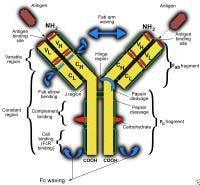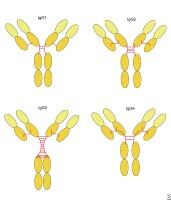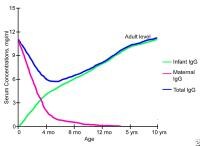Immunodeficiency diseases are commonly labeled into disorders that affect a number of of the 4 major limbs of the immune device. These limbs are (1) B cells, ie, humoral immunity; (2) T cells, ie, cell-mediated immunity; (3) phagocytes; and (4) complement.
B-cell immunity is mediated through the immunoglobulins and is usually referred to as humoral immunity. Humoral immunity is differentiated from T-cell immunity, which is often referred to as cellular immunity, and from phagocytic cell immune function. Immunoglobulins, which are protein molecules that incorporate antibody task, are produced via the terminal cells of B-cell differentiation referred to as plasma cells. Immunoglobulins have important roles in humoral immunity, they usually include 5 major lessons or isotypes: immunoglobulin G (IgG), immunoglobulin A (IgA), immunoglobulin M (IgM), immunoglobulin D (IgD), and immunoglobulin E (IgE). the most abundant category of immunoglobulins in the blood is IgG (73%), which has a molecular weight of 150 kd. IgG is current in plasma and exterior secretions and is expressed on the B-cell membrane.
 Immunoglobulin G deficiency. Schematic illustration of an immunoglobulin G molecule. CH signifies regular region of heavy chain; CL, consistent area of sunshine chain; VH, variable region of heavy chain; and VL, variable area of sunshine chain.
Immunoglobulin G deficiency. Schematic illustration of an immunoglobulin G molecule. CH signifies regular region of heavy chain; CL, consistent area of sunshine chain; VH, variable region of heavy chain; and VL, variable area of sunshine chain.IgG is further subdivided into four subclasses: IgG1, IgG2, IgG3, and IgG4. luckily, for ease of recollect, the serum concentrations of the subclasses instantly correlate with their numerical nomenclature, such that IgG1 is present in better concentrations than IgG2, etc.
 Immunoglobulin G deficiency. Human immunoglobulin G subclasses.
Immunoglobulin G deficiency. Human immunoglobulin G subclasses.In 1952, Bruton described classic X-linked agammaglobulinemia because of B-cell deficiency in an 8-12 months-outdated boy. the child introduced with popular pyogenic infections, repeated episodes of sepsis with the same serotypes of pneumococcus, and more than one episodes of mumps, but he had no antibodies in opposition to these pathogens. Serum protein electrophoresis had just become to be had, and it published that the g fraction was once missing from the infant’s blood.. therefore, patients had been described who had detectable lymphoid tissue and B-cells but had decreased IgG levels and/or lacked explicit antibodies. These conditions are now identified as becoming the categories of hyper-IgM syndromes and common variable immunodeficiency (CVID).
in the early 1960s, following the discovery of the IgG subclasses, certain associations had been also known between person subclass deficiencies, lowered means to reply to certain varieties of antigens (ie, bacterial polysaccharides), and recurrent an infection. IgG deficiencies may just happen as isolated deficiencies (eg, selective IgG deficiency) or in association with deficiencies of other immunoglobulin varieties. furthermore, even supposing the full IgG focus is standard, deficiencies of one or more person IgG subclasses, vital decreases in specific IgG antibodies, or each is also seen.
For knowledge on deficiencies of other immunoglobulin sorts, see the Medscape Reference articles IgA Deficiency, IgD Deficiency, and IgM Deficiency.
NextPathophysiology
B and T cells are liable for specific immunity, in any other case referred to as adaptive immunity. Adaptive immune responses require rearrangement of the genes accountable for the specific recognition constructions, ie, immunoglobulins for humoral immunity and T-cell receptors for mobile immunity. incapability to kind these reputation constructions or blocks in the differentiation and building of both of those cell types leads to main immune deficiency. strange production of these cells can also be observed in scientific states by which manufacturing of extraordinary cell types is pathologically extreme (eg, lymphoproliferative illnesses such as lymphoma and leukemia) or in immunodeficiency disorders in which manufacturing is aberrantly low.[1] Humoral immune defects may additionally end result from extreme lack of antibody proteins (eg, protein-losing enteropathy, sure sorts of nephritis), despite the fact that the B-cell mass could also be commonplace in those prerequisites.
IgG is neatly dispensed in intravascular and extravascular areas and is necessary within the secondary antibody responses (immune memory). It performs crucial position in host safety in opposition to infection. IgG protects tissues from bacteria, viruses, and toxins. completely different subclasses of IgG neutralize bacterial toxins, prompt complement, and fortify phagocytosis by means of opsonization.[2]
Importantly, notice that a low IgG degree, with normal IgA and IgM levels, does now not essentially equate with antibody deficiency. The analysis of particular antibody responses is crucial for the prognosis and for appropriate treatment.
For ease of discussion, IgG deficiencies is also divided into 2 classes. the primary is selective IgG deficiency, which consists of an isolated deficiency of IgG with customary levels of IgA, IgM, IgD, and IgE. The 2d is a deficiency of IgG accompanied by inadequate levels of alternative immunoglobulin isotypes. this will occur in more than a few conditions, together with X-linked agammaglobulinemia (X-LA), in style variable immunodeficiency (CVID), and hyper-IgM syndromes.
These disorders happen in individuals of any age or sex. Selective immunoglobulin deficiencies have been up to now referred to as late-onset agammaglobulinemia, and now they are classified below the final designation of antibody deficiency. each pediatric and grownup populations could also be suffering from particular or selective antibody deficiencies, CVID, or both. See popular variable immunodeficiency for extra small print.
IgA deficiency is the commonest immune deficiency. even though some "standard" blood donors may be found to be deficient in IgA, roughly 20% of patients who lack IgA are additionally poor in IgG2 and IgG4. These individuals appear to have a better risk of an infection than sufferers with remoted IgA deficiency.
PreviousNextEpidemiologyFrequencyUnited States
even though the frequency of isolated IgG deficiency will not be identified with walk in the park, deficiencies in specific IgG antibody or IgG subclass is almost definitely extra widespread and happens in households with popular variable immunodeficiency (CVID). Some reviews indicate that the incidence of IgG deficiency could also be 1 case per 10,000 individuals.
Mortality/MorbidityEarly prognosis and therapy of IgG deficiency is crucial to prevent and keep watch over each morbidity and mortality.IgG subclass ranges are highly variable, even within folks at totally different closing dates. Their development in early childhood varies from subclass to subclass; IgG 2 is the slowest to achieve adult values. further deficiencies could turn out to be apparent as a result of defective switching between completely different IgG subclasses. SexMales and ladies are affected.Age
each youngsters and adults are affected. kids youthful than 24 months cannot make a lot IgG2; therefore, measuring the IgG2 subclass concentration prior to this age is not significant.
the most typical subclass deficiency in early childhood is IgG2 deficiency; in adults, IgG1 and IgG3 deficiencies predominate. IgG1 debts for the next share of the total IgG in children as in comparison with adults. even though children rapidly obtain adult levels of IgG1 and IgG3, the improvement of IgG2 and IgG4 is slower. In some kids, maturation of the full vary of IgG subclasses may be delayed except the teenage years. observe the determine under.
 Immunoglobulin G deficiency. modifications in serum immunoglobulin G concentrations throughout infancy and childhood.
Immunoglobulin G deficiency. modifications in serum immunoglobulin G concentrations throughout infancy and childhood.One latest study found an isolated IgG3 subclass deficiency used to be the commonest IgG subclass deficiency in Thai children. IgG3 subclass deficiency, both remoted or combined with different IgG subclass deficiency, was once present in eighty five.5% of 55 youngsters, most of whom have been first evaluated for recurrent sinusitis.[3]
PreviousProceed to medical Presentation , Immunoglobulin G Deficiency

No comments:
Post a Comment
Note: Only a member of this blog may post a comment.